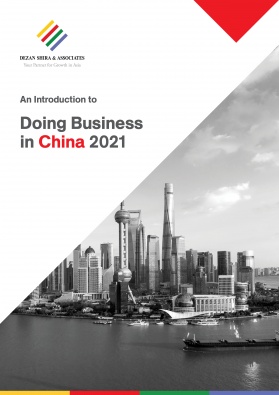Key IT Considerations and Solutions for Your Back Office Automation in China – Part 1
In this two-part series, we discuss solutions for back office automation in China. This includes ways to manage key considerations, such as accessing trustworthy support and reliable information resources on-the-ground, knowledge of IT software and service options unique to China, legal compliance, and cyber and data security concerns.
Part 1 focuses on two major considerations and offers relevant solutions for the same: first, tackling information resource gaps to facilitate effective decision-making in a sensitive market like China, and second, ensuring the operational stability of your back office set up in China.
In Part 2, we will discuss solutions to maintain cyber security and compliance for foreign firms setting up operations in China and ways to strengthen IT support on the ground.
Back office automation in China
A company’s ‘back office’ refers to the technology, services, and human resources required for a company to manage itself. These services may collectively cover the information technology (IT), human resources (HR), payroll, accounting, and administration departments of a company. The role of back office systems and services is to support front office functions, which support clients and generate company revenues. As such, back office services are vital to a firm’s operations and its profitability.
For this reason, more and more companies are taking actions to automate their back office operations and digitize to bring functions online. There are many drivers behind this shift – to improve quality, efficiency, and transparency; to digitize their records; integrate a function with other apps, functions, and processes; and lately, to enable remote work in the post-COVID-19 new normal. The advantages of taking these increasingly simple steps is clear but how might a company ready its technology environment to implement these changes?
Traditionally, companies approached the automation of their overseas processes in China by extending their enterprise system from headquarters (HQ) to China, possibly leaving gaps in local compliance and compatibility. Smaller firms would try to skip this step to save costs, by implementing local software that may not be HQ-compliant or compatible.
Today, companies in China enjoy an increasing range of better options, often in the form of software-as-a-service (SaaS) or other cloud-based solutions that offer the best of both worlds, and with solutions that can integrate into their existing corporate structures. Such options can be highly advantageous, but they can also result in a growing eco-system of apps that each address increasingly specific functions. This could then invite new downstream problems, such as risks to cyber security and personal data protection.
Regardless of which approach is taken, most companies face a range of unique challenges specific to China, which begins the moment that a new option or need arises.
In this article, we provide a quick review of those challenges and share some on-the-ground experience and expertise about how to overcome these challenges.
Lack of ground-level information for decision-making
Each company faces a range of decision points along their transformation and digitalization paths.
Generally, companies can run without big IT problems in daily operations, if they have a trustworthy IT advisor(s) in China or in the HQ overseas. However, this may no longer be enough, in the context of back office automation.
To support the transformation to a tech-powered back office in China, the IT advisors must be competent across a range of diverse back office functions, especially with respect to how these functionalities apply and are regulated in China. For example, an HR app may perform well for your staff, management, and IT teams but may be only minimally compliant with changes in China HR law. If the IT advisors don’t have expertise to spot risks like these, they may take decisions leading to potential compliance issues in the future.
The on-the-ground knowledge and experience required for decision-making impose great challenges upon in-house IT advisors, because transformation technologies by their nature evolve rapidly, and in this regard, China’s IT environment is moving in its own fast lane.
Solutions
Generally, the below problems need to be considered to gain the depth and comprehensiveness of information that are necessary in areas key to technology transformation in China:
Often, it is the senior IT staff, such as IT director and Chief Information Officer in China or in HQ overseas, who are relied upon to provide expert guidance when selecting systems and strategies.
- How will a solution work in terms of data compliance or integration with third-party payment platforms?
- What differences exist between this solution and the company’s standard system, and what is its path to integration (typically there should be one)?
- What regulatory areas must a technology solution be compliant with, how often does this tend to change in the market, and what commitments does the solution provider make in this regard?
- How would data rights and ownership work while using the tech service, and if services were to be later terminated?
To make risk-averse choices in China, companies are advised to retain one or more advisors who have robust, active, in-China expertise and involvement in multiple cloud and back office solutions of importance to the company and who are able to address – at minimum – the areas of user experience and productivity, integration/compatibility, continuity, data, compliance, security, and support.
Challenges in ensuring the stability and continuity of the back office system
Whether the company is extending a centralized system into China or adding a local system into its global environment, successful configuration of the system is just the first step. The next focus should be to take steps towards enabling a better performing and ‘work-anywhere’ system. This requires that the corporate system and networks perform reliably and stably to support this new workload.
Common challenges faced in maintaining back office systems’ performance and continuity are as follows:
Efficiency issue
Many companies may have deployed the systems successfully but some of them face efficiency issues, which impact the business on a certain level. The lack of efficiency might be related to communication, slow access to the system, manual or complex operation inside the system, lack of prompt training to end users and on-time support, among others. For example, smaller offices sometimes do not have a managed network environment. For companies that use SaaS or other cloud-based back office systems hosted outside of China, or corporate systems that are hosted on IT infrastructure at their headquarters, network speed and stability can be a common and painful issue, while the solution for speeding up the access comes at extra cost.
Reliability issue
Another challenge commonly observed in adopting tech-powered solutions relates to how to make the system/platform run in a reliable and stable way. For smaller companies, the limitation of the budget usually results in a lack of redundancy of the hardware or software, which produces the potential risk of ‘single-point-of-failure’. To explain further, critical systems should be running on clustered servers and hardware to be able to recover the service instantly in the event that a single hardware or software failure occurs. Similar situations arise for other IT facilities, such as internet connection, network device (firewall or switch), power supply, etc.
Solutions
Based on our experiences with clients, the below tips can be considered to mitigate the challenges.
SaaS and cloud-first strategy
For most firms, a SaaS or other cloud-based solution is the first essential step for achieving a work-anywhere system. However, it can also be highly advantageous for smaller companies to select SaaS or other cloud-based back office solutions, in order to meet the many other challenges mentioned above. Such solutions often provide a better performing, more reliable experience, compared with on-premise infrastructure, and they help companies to avoid large long-term expenditure. Today, such solutions are increasingly able to integrate with corporate and third-party systems as well.
Internet speedup and backup
It is well known that operations in China, which depend on connecting with international websites and servers, can face major challenges. Many companies fail to recognize that traffic behavior on their own office network may be causing efficiency issues for users in China. In order to achieve a well performing network without spending unnecessarily, a company must perform simple but thorough network testing in order to identify the most significant bottleneck issues.
To improve international internet traffic performance, after evaluating the cost and quality of the affordable options, companies often receive the most gains by upgrading their last mile internet, or by upgrading to a cross-border internet solution, such as leased lines or SD-WAN. However, a range of third-party solutions exist.
For reliability, companies can often implement a redundant last mile internet connection quite affordably, such as via an inexpensive secondary ADSL link as a backup to ensure continuity of the back office automation systems.
It is also worthwhile to note that, sometimes, the burden of depending on international traffic performance for back office automation can be reduced or removed entirely in cases where your SaaS or other cloud-based services are hosted in-country, or within nearby regions. When planning and setting up your cloud services, it is advisable to properly understand where the servers will be based, and to test how those servers will perform in China in different conditions.
Unified Communications platform
Certainly, one critical platform that can provide great support for back office automation tools in use within your organization is one that helps to improve efficiency through better communication, integration, and sharing. A Unified Communications (UC) platform integrates different communication methods, such as audio, video, instant message, file sharing, screen sharing, and even workflow automation and can be very useful for the support of all systems and daily operations, especially for supporting frequent interactions among teams located in multiple offices.
The selection of the right UC tool also helps to ensure that more information is exchanged securely. This can help to not only prevent data leakages, compared with common alternatives used by staff, such as QQ, WeChat, and other ‘shadow IT’ platforms. Choosing the right platform is very important for achieving the right balance of accessibility, adoption, compatibility, and security.
Thomas Zhang is the Group IT Director at Dezan Shira & Associates, based in the Shenzhen office.
About Us
China Briefing is written and produced by Dezan Shira & Associates. The practice assists foreign investors into China and has done so since 1992 through offices in Beijing, Tianjin, Dalian, Qingdao, Shanghai, Hangzhou, Ningbo, Suzhou, Guangzhou, Dongguan, Zhongshan, Shenzhen, and Hong Kong. Please contact the firm for assistance in China at china@dezshira.com.
Dezan Shira & Associates has offices in Vietnam, Indonesia, Singapore, United States, Germany, Italy, India, and Russia, in addition to our trade research facilities along the Belt & Road Initiative. We also have partner firms assisting foreign investors in The Philippines, Malaysia, Thailand, Bangladesh.
- Previous Article Investing in Xinjiang: Economy, Industry, Trade, and Investment Profile
- Next Article China’s Tax and Fee Cuts Extended or Released After 2021 Two Sessions








